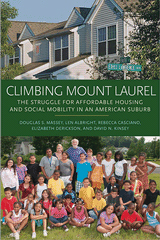- NJASA
- Community Corner - Dec13/Jan14
-
Climbing Mount Laurel-Evidence of Equal Educational Success
 As superintendents, we often find ourselves in the midst of conversation encouraging constituencies to focus on what is most important and not become distracted by “fads.” All too often, the sound bite of the message becomes the focus - not the evidence. It is important to compliment our success with evidence that is research-supported… to give it a voice.
As superintendents, we often find ourselves in the midst of conversation encouraging constituencies to focus on what is most important and not become distracted by “fads.” All too often, the sound bite of the message becomes the focus - not the evidence. It is important to compliment our success with evidence that is research-supported… to give it a voice.The book, “Climbing Mount Laurel: The Struggle For Affordable Housing and Social Mobility In An American Suburb” does just that. Published by Princeton University Press, it details an extensive research project conducted by Princeton Professor Douglas Massey and associates into the impact of the Ethel Lawrence Homes in Mount Laurel, and comprises the final chapter in a story that began in 1967.
Rich in data and research-intense, Climbing Mount Laurel looks at the outcome of the struggle for affordable housing begun by Mount Laurel resident Ethel Lawrence and affirmed by the State Supreme Court more than 30 years ago. It debunks preconceived notions about a drop in home values and tax assessments, and a rise in crime, when affordable housing is developed in affluent suburban communities.
Many of the findings of the Monitoring Mount Laurel Study are surprising. Among residents of the Ethel Lawrence Homes, the affordable housing project built in 2000, welfare dependence was reduced by 67-percent, employment rose by 22-percent and income increased by 25-percent. Most significant to those of us in education, however, were the findings involving school-aged residents. In that group, school quality was found to be 2.3 times greater for students living in Ethel Lawrence Homes than those in the comparative community group.
Parents in the affordable housing group were 40-percent more likely to check homework and eight times more likely to take their children to the library than their neighbors in the next community. Despite attending more challenging schools, their grades were slightly higher than those in the comparison group.
Rather than focus on creating competitive systems that dilute resources to public schools, “Climbing Mount Laurel” provides the quantitative evidence that supports what all of us already know: if you really want all kids to achieve academic success you must create solid and meaningful partnerships with the community and give educators the resources and autonomy to inspire all children to learn.
When educators can cut through the noise and work with community advocates in a meaningful way, we can develop a sensible plan that focuses on the simplicity, clarity and priority of educating all children in their public school. “Climbing Mount Laurel” is the evidence of one district, one community, and one partnership in making public schools work for all of its children.



